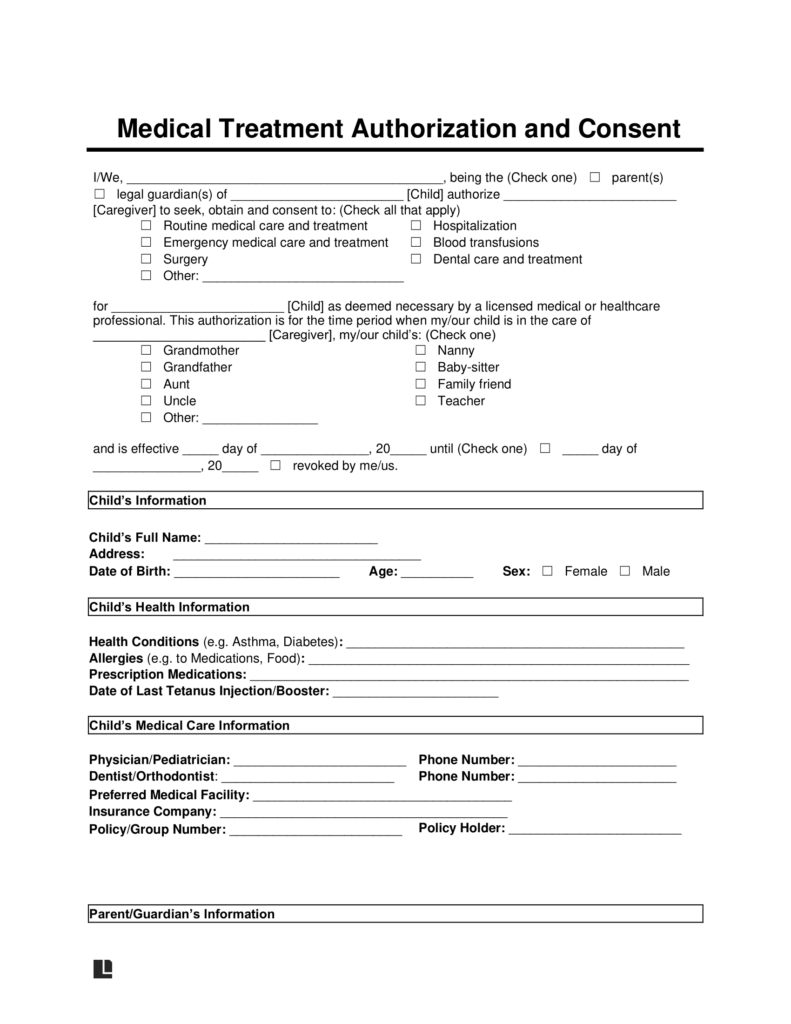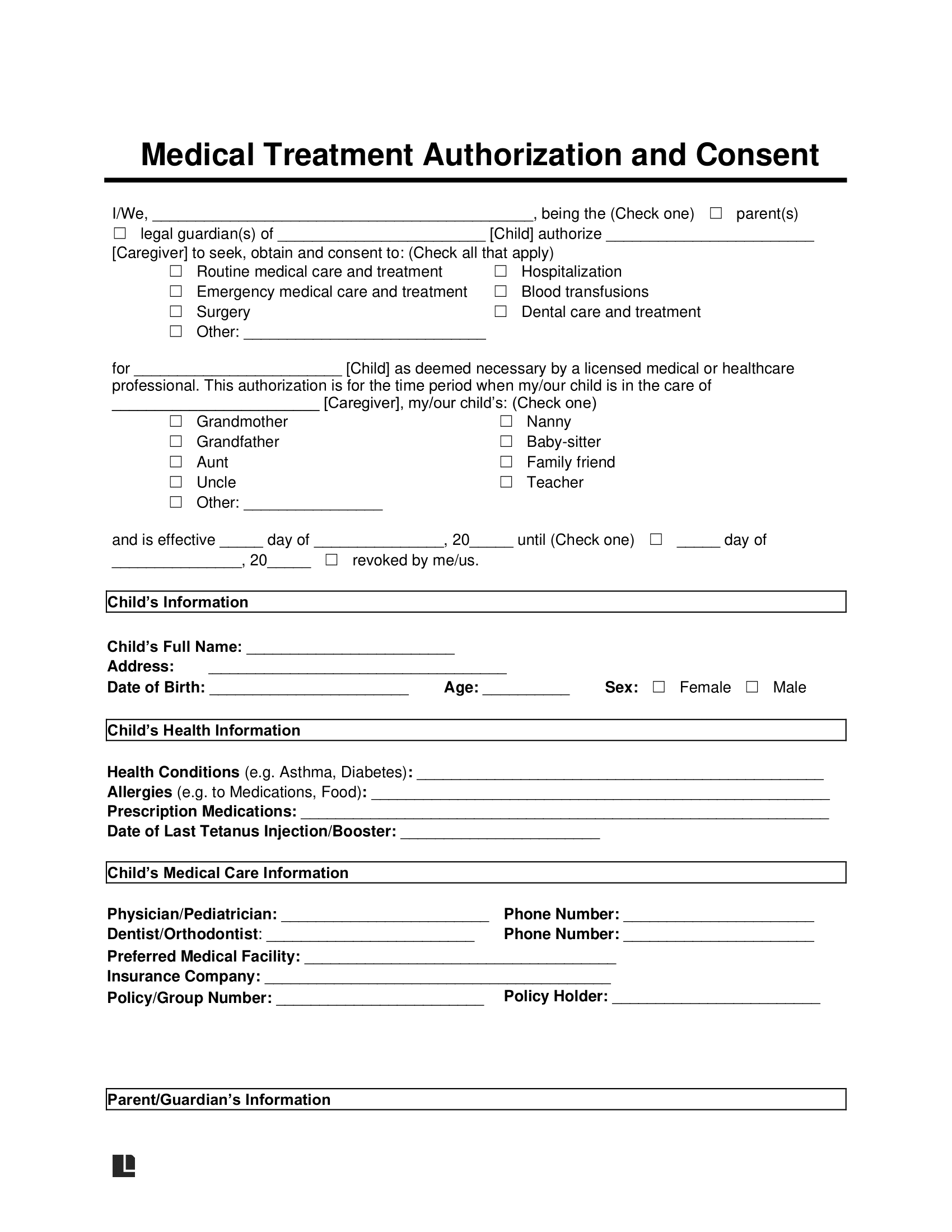A child (minor) medical consent form allows another adult (besides a parent or legal guardian) to make healthcare decisions for someone under the legal age when their parents or guardians are unavailable. The legal age varies by state, but it’s commonly under 18.
Supplementary Forms
If a parent or legal guardian is not traveling with their kid, they often pair a child medical consent form with a child travel consent form.
Furthermore, a minor (child) power of attorney lets them grant a trusted adult the authority to make broad decisions on a child’s behalf, potentially relating to their healthcare and education.
What Is a Child Medical Consent Form?
A child medical consent form is a written document authorizing a designated adult to make healthcare decisions for a minor child. As a parent, you may need a grandparent, aunt, uncle, family friend, nanny, babysitter, or daycare provider to care for your child at some point. If a medical emergency arises, it’s important these individuals have the authority to approve medical treatments.
According to the American Academy of Pediatrics, healthcare workers can only provide emergency care without parental consent if the child’s life is in danger [1] . So, you can execute a child medical consent form to get prompt medical treatment for your child without obstacles.
Ways to Give Consent
Written consent is preferable, as it gives advance notice that someone other than a child’s parent or legal guardian has authority over treatment and care authorization.
However, verbal consent may be given in emergencies when written consent isn’t feasible, and the child needs immediate treatment.
Why Is It Important?
Explore the importance of a child medical consent form by reviewing the benefits it offers:
- It lets you designate a trusted individual. Electing a trusted individual to have authority over your child’s health care can give you peace of mind in case your child is involved in an accident or comes down with a sickness while you’re unavailable.
- It reduces delays in care. If your child is experiencing an emergency and needs prompt treatment, a consent form lets a preselected person who may be in their presence make medical decisions on their behalf.
- It ensures continuity and high-quality care. This form creates clarity surrounding your child’s health care, minimizing misunderstandings and providing healthcare professionals with clear instructions.
When Is It Necessary?
A child medical consent form is needed when a child’s parents or legal guardians aren’t readily available or present to give consent for medical treatment. Here are some actions a caregiver can complete when they have the consent that this form grants:
- Obtain Medical Records: A parent/guardian may allow a caregiver to obtain a child’s medical records so they can make educated treatment plans if an emergency arises. Some healthcare providers may require a separate medical records release form so they can access previous health records.
- Consent to Routine Evaluations and Treatments: This form can let a caregiver consent to routine evaluations and treatments, including routine vision and hearing tests, staple removal, or vaccinations.
- Authorize Non-Routine Healthcare: This form can also give a trusted individual authority to make non-routine healthcare decisions that may involve experimental treatments, surgical interventions, and life support measures.
States Laws on Minor Consent
Review a list of state laws pertaining to medical consent for minors:
| State | Child Consent Laws for Routine Medical Care | Child Consent Laws for Infectious Disease Treatment |
|---|---|---|
| Alabama | Ala. Code § 22-8-4 | Ala. Code § 22-8-6 |
| Alaska | Alaska Stat. § 25.20.025 | Alaska Stat. § 25.20.025 |
| Arizona | Ariz. Rev. Stat. § 44-132 | Ariz. Rev. Stat. § 44-132.01 |
| Arkansas | Ark. Code § 20-9-602 | Ark. Code § 20-16-508 |
| California | Cal. Fam. Code § 6922 | Cal. Fam. Code § 6926 |
Can a Child Consent to Their Own Medical Treatment?
A child living with their parents can’t usually consent to their own medical treatment until they reach the legal age. The legal age is usually between 18 and 21 in most states, but some states have a lower legal age. Some states may make exceptions if the child:
- Shows adequate understanding of the treatment plan and associated risks.
- Serves in the military.
- Is married.
- Lives apart from their parents.
- Manages their own finances.
- Can’t reach their legal guardians or parents.
Steps to Granting Medical Consent for a Minor
Follow these steps to grant medical consent for a minor:
- Familiarize yourself with legal requirements. Learn the legal requirements in your jurisdiction, including the types of treatment that require parental authorization and who can provide consent in the parents’ absence.
- Fill out the consent form. Specify your child’s personal information and your contact details.
- Write the authorized procedures. Explain which procedures you’re allowing someone else to consent to on your child’s behalf.
- Designate a caregiver. Name a person you trust as the person who can make decisions on your child’s behalf.
- Read and sign. Review the document and sign.
- Issue copies. Issue a copy to the authorized individual and retain one for yourself.
- Inform healthcare providers. Distribute the form to healthcare providers who may need to know about the authorization, such as your child’s primary care provider.
How to Write a Child Medical Consent Form
Step 1 – Include the Child’s Information
Include the child’s full name, sex, date of birth, age, and address. The child is authorized by their parent or legal guardian to receive medical treatment when under the care of another person.
Step 2 – Fill in the Parent/Legal Guardian’s Information
The parent or legal guardian is the person who is giving consent for their child to receive medical treatment when they are not present. Include the guardian’s full name and contact information, such as their address and phone number.
Step 3 – Provide the Caregiver’s Information
Specify who will authorize medical treatment in the parents’ absence. Write the caregiver’s name and their relationship to the child.
Step 4 – Write Down Emergency Contact Information
Include the contact information for an emergency contact person the caregiver can contact if they can’t reach the child’s parent or legal guardian when the child is under their care.
Consider providing an alternative emergency contact person. This way, the caregiver will have a secondary option if the first emergency contact can’t help or doesn’t respond to a phone call.
Step 5 – Clarify the Medical Treatment
You can choose the range of medical care in your child’s treatment. You may authorize the caregiver to decide on specific types of medical care, such as:
- Routine examinations and checkups
- Emergency medical treatment
- Emergency medical transportation
- Diagnostic imaging (x-rays, CT scans, MRIs)
- Medication administration
- Anesthesia-induced surgical procedures
Include the start date of the medical authorization and consent. Express how long the consent is valid. You can end it on a specific date or leave it valid until you decide to revoke it.
Step 6 – Provide Health and Medical Care Information
This information can help medical and healthcare workers make quick and effective diagnoses and decisions. Include as much information as possible about your child’s medical history, such as their last tetanus shot, whether they have any known medical conditions or allergies, and if they’re taking any prescription medications.
Ensure to provide the following additional information to improve the chances of your child receiving timely medical attention:
- The child’s primary doctor
- The child’s primary dentist/orthodontist
- Your preferred medical facility for the child’s treatment
- Insurance company name and other insurance information
Step 7 – Sign the Document
You can include witness signatures or have the form notarized in front of a notary public when you want to sign the document.
The decision to include witnesses or notary acknowledgment on child medical consent forms varies by state. Check with your local or state law to ensure medical and healthcare professionals will recognize the form.
In certain states, you can seek online notarization. Check with a local notary to see if you can obtain remote online notarization and still have a valid, legally binding document.
Sample Child Medical Consent Form
Download a sample child medical consent form in PDF or Word format:

Frequently Asked Questions
Do both parents have to consent to medical treatment for a child?
No. Both parents don’t have to consent to medical treatment for a child. For married couples, the permission of one parent is enough for the child to receive healthcare. A divorced parent with joint or sole legal custody can also make healthcare decisions on their child’s behalf.
Some joint custody agreements state that both parents must consent to medical treatment. If the parents can’t agree, they must take the matter to court and have a judge decide. The judge may have them create a parenting plan to outline these essential details.
Does a child medical consent form need to be notarized?
A child medical consent form needs notary acknowledgment in most cases. Having both parents sign the document before a notary public increases its authenticity and ensures it’s legally binding. You may also have witnesses observe the signing.
Can grandparents give medical consent?
Yes, grandparents can give medical consent if a parent or legal guardian has authorized them to make healthcare decisions for the child.
The grandparent must present a signed medical consent form before the child can receive medical care. In an emergency, the document is essential as healthcare professionals will not perform medical procedures until they see they have permission.
If you grant a grandparent authorization, you should ensure they store the document in an accessible place. This way, your child can then receive medical care without delay, and you can avoid unnecessary stress.
